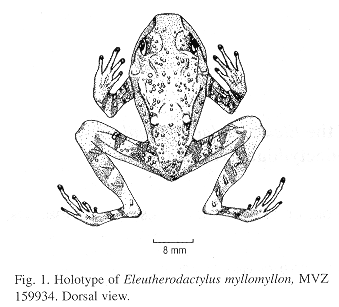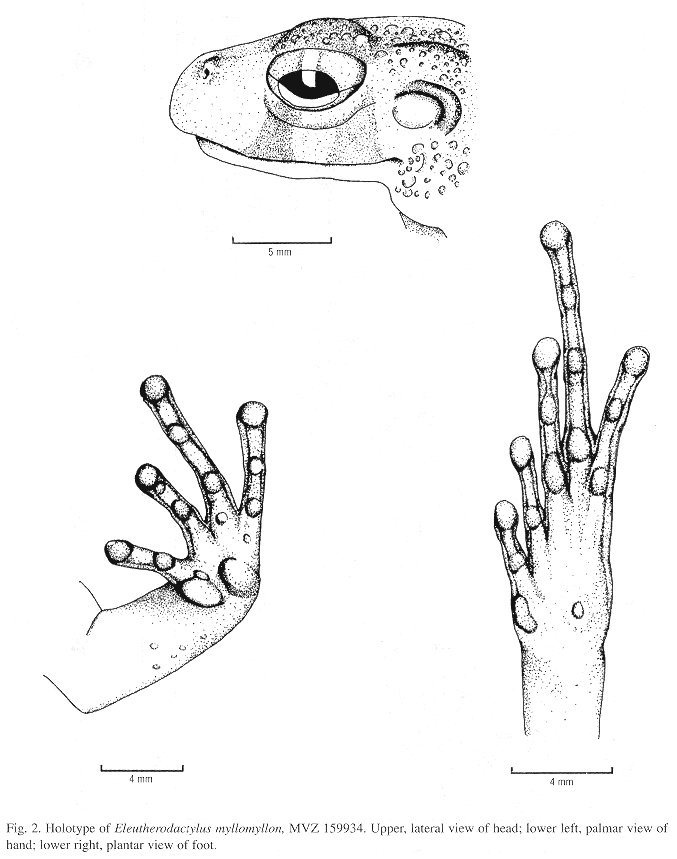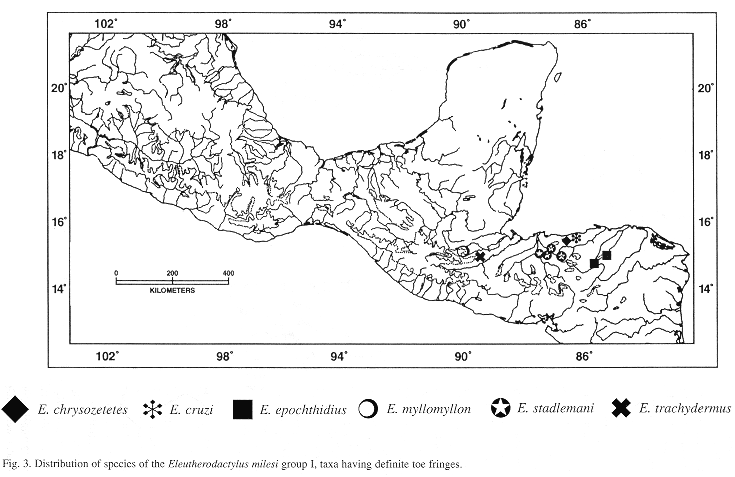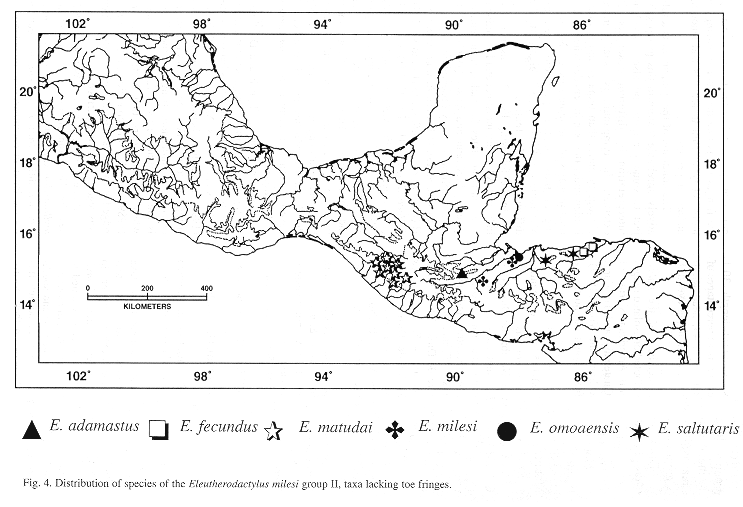Revista de Biología Tropical
versión On-line ISSN 0034-7744versión impresa ISSN 0034-7744
Rev. biol. trop vol.48 no.4 San José dic. 2000
(Amphibia: Anura: Leptodactylidae) from Guatemala
Jay M. Savage1
Received: 30-VI-99 Corrected: 13-IV-00 Accepted: 24-V-00
Abstract
A new rainfrog of the Eleutherodactylus milesi group is described from the Sierra de Xucaneb, Guatemala. It is compared to the other 11 upland species from southern Mexico, Guatemala and Honduras referred to the group. Within the milesi group the new species differs from the other five forms which also have toe fringes in size of the finger disks, the snout shape in profile and the amount of toe webbing and dorsal tuberculation. Difficulties in distinguishing among the character states for the tympanum (distinct, indistinct and hidden) and between toe ridges and fringes indicate that very subtle differences separate recognized species.
Key words
Amphibia, Anura, Leptodactylidae, Eleutherodactylus, Guatemala.
Some years ago a single rather ordinary appearing Eleutherodactylus was collected by Robert Seib, then at the University of California, Berkeley, from the Sierra de Xucaneb of Guatemala (Savage 1975). McCranie et al. (1989) concluded that this specimen belonged to the Eleutherodactylus milesi group (sensu Savage 1987). Recent reviews of the milesi group (Campbell 1994; McCranie and Wilson 1997) indicate that this frog differs substantially from all other members of that species group. Since a description of a new species is a hypothesis that material at hand represents an actual entity, it is here proposed that the Guatemalan frog is an example of a distinctive taxon to be known as:
Eleutherodactylus myllomyllon, sp. nov.
Figs. 1-3
Holotype: Museum of Vertebrate Zoology, University of California, Berkeley (MVZ) 159934, an immature female from Finca Volcan, Sierra de Xucaneb, Departamento de Alta Verapaz, Guatemala, 875m; collected 31 July 1978 by Robert Seib.
Diagnosis: A member of the Eleutherodactylusmilesi group: Savage (1987), McCranie et al. (1989), Campbell (1994), McCranie and Wilson (1997), having toes with moderate amounts of webbing and distinct lateral fringes, smooth and unflared lips, the dorsum covered with widely spaced, moderate-sized tubercles, the tympanum evident but indistinct and the annulus tympanicus hidden in the single known female.
This species differs from Eleutherodactylus adamastus and E. matudai of Guatemala and E. fecundus, E. milesi, E. omoaensis and E. saltuarius of Honduras in having toe fringes and an obtuse snout profile. The toes are without fringes but sometimes have lateral keels and the snout is rounded to vertical in profile in the six aforementioned forms.
Eleutherodactylus chrysozetetes, E. cruzi, E. epochthidius and E. stadelmani of Honduras and E. trachydermus of Guatemala, share the toe fringe feature with E. myllomyllon. The new species differs from E. chrysozetetes in having much less toe webbing (toe webbing 4 IV 4 versus 3 1/3 IV 3 1/3 in the latter form), less expanded finger disks (disks little wider than digits versus about twice width of digits) and numerous tubercles on the dorsum (wrinkled, nearly smooth dorsum in the latter species). The new form differs from the other Honduran forms with toe fringes in having the combination of an obtuse snout profile (rounded to vertical in the other species) and the dorsum wrinkled with widely spaced moderate-sized tubercles. In addition, unlike E. epochthidius, it has fringes on toes II-IV not on toes III-IV or only toe IV and the tympanum is evident but indistinct in the female type (hidden in E. cruzi and E. stadelmani). E. myllomyllon is distinguished from E. trachydermus (features for the latter in parentheses) by having moderate, widely scattered tubercles on the dorsum (dense, large tubercles), a smooth, unflared upper lip (margin of lip rough and lip flared under the orbit) and the snout obtuse, in profile (truncate).
Summary of Characteristics: Descriptors throughout this paper follow Campbell (1994), and McCranie and Wilson (1997). Snout rounded in dorsal outline, obtuse (sloping) in profile; canthus rostralis concave in dorsal outline, rounded in cross-section; loreal area obtuse in cross-section; upper lip smooth; head slightly longer than broad; choanae moderate, ovoid; vomerine odontophores round, slightly larger than choanae, well posterior to choanae and narrowly separated medially; eyelids covered mostly with small low tubercles, cluster of large, low warts at medial posterior margin; tympanum indistinct, annulus not evident; definite supratympanic ridge from eyelid on each side, curving downward behind tympanum to behind axilla; dorsum covered with widely spaced moderate-sized tubercles; prominent paired suprascapular, hour-glass shaped ridges and low presacral ridges present; other short pearl-colored ridges on anterior flanks. Finger II longer than finger I; relative finger lengths: III>IV>II>I; finger disks slightly expanded, disk on finger III 52% of length of tympanum; fingers with lateral keels; subarticular tubercles on all digits, round, flattened; no supernumerary subarticular tubercles on any digits; thenar tubercle, elongate, bifid or double; palmar tubercle round, large; accessory palmar tubercles small; all tubercles under hand low in profile; heel with numerous small tubercles and one large, flat one on dorsal surface; no tarsal fold or tubercles; toe disks slightly larger than finger disks; toes with well-developed lateral fringe; toe webbing moderate, formula: I 2+ - 2 3/4 II 2 - 3 1/2 III 3 - 4 IV 4 - 2 1/2 V; toe III about as long as V; relative toe lengths: IV>III>V>II>I; tiny planter tubercles present; inner metatarsal tubercle, elongate, outer round and smaller; both low in profile; venter coarsely, wrinkled, not areolate.
Coloration: In Preservative: Upper surface brown with tips of tubercles cream; suprascapular and presacral ridges cream, outline by darker brown; light interorbital bar indistinct, demarcated posteriorly by narrow dark brown bar; lip barred but light areas suffused with some brown pigment; supratympanic ridges cream, bordered by dark brown paired dark suprascapular and supra-axillary dark spots; limbs weakly barred with dark bands; posterior thigh surface same color as dorsum, anterior surface light tan; paired paracloacal light stripes present; chin, throat and venter pale cream punctuated with scattered melanophores; undersurfaces of limbs pale cream.
Measurements: Standard length 30.1 mm; all other measurements as percentages of standard length: head length 45; head width 42; tympanum length 8; width upper eyelid 9; tibia length 63.
Remarks: The members of the milesi group are widely distributed on isolated ranges in the North Central American Sierras of Chiapas, Mexico, Guatemala and Honduras (Campbell, 1994; McCranie and Wilson, 1997).
Distributions from south to north are (Figs. 4-5):
Sierra Agalta (700-1450m), eastcentral Honduras -- E. epochthidius
E and C Cordillera de Nombre de Dios (400-1260m), eastern Honduras -- E. fecundus
Mountains of Olancho and Yoro Provinces (1125-1900m), northcentral and northwestern Honduras -- E. stadelmani
C Cordillera de Madre de Dios (880-1130m), northcentral Honduras -- E. chrysozetetes
C Cordillera de Madre de Dios (1520m), northcentral Honduras -- E. cruzi
C and W Cordillera de Madre de Dios (1550-1800m), northwestern Honduras -- E. saltuarius
Sierras Oma and Espiritu Santo (1050-1720m), northwestern Honduras -- E. milesi
Sierra Omoa (760-1150m), northwestern Honduras -- E. omoaensis
Sierra de las Minas (600-650m), Guatemala -- E. adamastus
Sierra de Xucaneb (875m), Guatemala -- E. myllomyllon
Sierra de Santa Cruz (900m), Guatemala -- E. trachydermus
Pacific Slope (1500-2000m), Chiapas, Mexico and adjacent Guatemala -- E. matudai
Principal differences among these taxa involve subtle distinctions in dorsal skin texture, snout profile, toe webbing, upper lip shape and degree of ear development. E. myllomyllon appears to be most closely allied to the Guatemalan species occurring in mountain ridges to the east (E. trachydemus) and southeast (E. adamastus) of the Sierra Xucaneb. It is somewhat intermediate between these forms, most closely resembling the former in having toe fringes but is like the latter in having an indistinct tympanum in females and smooth, unflared upper lips.
The condition of the tympanum is a relatively unreliable feature in this group subject to some variation and also individual interpretation by different observers. If external, the tympanum is usually more obvious in males than females and is often hidden under the skin in females when indistinct in males of the same species. My scoring of most of the specimens seen by McCranie and Wilson (1997) highlights the difficulty with this feature.
In the following list, D = distinct, I = indistinct, VI = very indistinct and H = hidden. The character states for males, then females given by McCranie and Wilson (1997) are listed first followed by my observation in parentheses: E. milesi, D-I (I-H); E. stadelmani;, H-H (I-H); E. epochthidius, I to H - I to VI (I-H); E. fecundus, I to H - I to H (I-H). Campbell (1994) agreed with McCranie and Wilson's (1997) scoring of E. milesi and my scoring of E. stadelmani, noting that some males had indistinct tympana. There is no disagreement in scoring for E. chrysozetetes and E. cruzi between us. I also agree with Campbell (1994) that E. trachyderma has the I-H conditions. I have not examined examples of E. omoaensis or E. saltuarius.
As pointed out by Lynch and Duellman (1997), a similar problem relates to the continuum of intermediate conditions between digital keels and fringes. McCranie and Wilson's (1997) distinction between E. epochthidius (fringes on toes III-IV or only toe IV) versus E. cruzi and E. stadelmani (fringes on toes II-IV) is rather arbitrary. This is further confirmed when one considers that McCranie et al. (1989) described the condition in E. cruzi as ridged in comparison to E. chrysozetetes which was regarded as having fringes.
If one uses McCranie and Wilson's (1997) key for Honduran forms, Eleutherodactylusmyllomyllon keys out to E. stadelmani. E. myllomyllon differs from E. stadelmani (features for the latter in parentheses) most notably in having a tympanum that is obvious, but covered by tuberculate skin (hidden in females) and an obtuse snout profile (rounded to vertical).
This new taxon is named in honor of Jonathan A. Campbell of the University of Texas, Arlington, in recognition of his many contributions to our knowledge of the Guatemalan herpetofauna. It is equivalent of the Scottish surname Campbell (wry lip) derived from the Greek myllos (bent) and myllon (lip). Those that know Jonathan well may see a connection between the name and his oral renditions of his Guatemalan adventures.
Distribution: Known only from the Sierra de Xucaneb, Guatemala, in Premontane Wet Forest (875m).
Acknowledgments
David B. Wake of the Museum of Vertebrate Zoology, University of California, Berkeley, kindly made the holotype available for study. The illustrations were prepared by Cristina Ugarte and the maps by Kathy Gibbs Thornton. Their help is greatly appreciated.
Resumen
Se describe una especie nueva del grupo Eleutherodactylus milesi hallada en la Sierra de Xucaneb, Guatemala. Se compara con las otras once especies del grupo (alturas de sureste de México, Guatemala y Honduras). Dentro del grupo, difiere de las otras cinco especies que tienen flecos de pulgar en el tamaño de los discos digitales, la forma del hocico visto de perfil y la cantidad de membrana del pulgar y de tubérculos dorsales. La dificultad de distinguir entre características del tímpano (definido, indefinido y oculto) y entre rebordes y flecos del pulgar indican que hay diferencias muy tenues entre las especies actualmente reconocidas.
References
Campbell, J. A. 1994. New species of Eleutherodactylus (Anura: Leptodactylidae) of the milesi group from Guatemala. Herpetologica 50: 398-411. [ Links ]
Lynch, J. D. & W. E. Duellman. 1997. Frogs of the genus Eleutherodactylus in western Ecuador. Natural History Museum, University of Kansas Special Publication 23: 1-236, 8 pls.
McCranie, J. R. & L. D. Wilson. 1997. A review of the Eleutherodactylusmilesi - like frogs (Anura, Leptodactylidae) from Honduras with the description of four new species. Alytes 14: 147-174. [ Links ]
McCranie, J. R., J. M. Savage & L. D. Wilson. 1989. Description of two new species of the Eleutherodactylus (Amphibia: Anura: Leptodactylidae) from northern Honduras. Proc. Biol. Soc. Washington 102: 483-490. [ Links ]
Savage, J. M. 1975. Systematics and distribution of the Mexican and Central American stream frogs related to Eleutherodactylus rugulosus. Copeia 1975: 254-306. [ Links ]
Savage, J. M. 1987. Systematics and distribution of the Mexican and Central American rainfrogs of the Eleutherodactylusgollmeri group (Amphibia: Leptodactylidae). Fieldiana Zool. n.s. 33: 1-37. [ Links ]
1Department of Biology, San Diego State University, San Diego, California, 92182-4614, USA; Fax: 619/380-3778, E-mail: savy1@home.com












 uBio
uBio 





